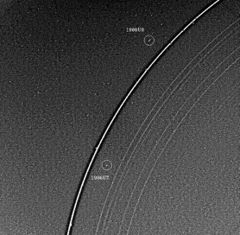أوفيليا (قمر)
 صورة اكتشاف أوفيليا (أعلى الصورة، خارج الحلقات) | |
| الاكتشاف | |
|---|---|
| اكتشفه | Richard J. Terrile / ڤويدجر-2 |
| تاريخ الاكتشاف | January 20, 1986 |
| التسميات | |
| تعيين الكوكب الأصغر | Uranus VII |
| النطق | /oʊˈfiːliə/[1] |
| الصفات | Ophelian /ɒˈfiːliən/[2] |
| السمات المدارية | |
Mean orbit radius | 53,763.390 ± 0.847 km[3] |
| Eccentricity | 0.00992 ± 0.000107[3] |
| 0.37640039 ± 0.00000357 d[3] | |
Average orbital speed | 10.39 km/s[أ] |
| Inclination | 0.10362 ± 0.055° (to Uranus' equator)[3] |
| Satellite of | أورانوس |
| السمات الطبيعية | |
| الأبعاد | 54 × 38 × 38 km[4] |
نصف القطر المتوسط | 21.4 ± 4 km[4][5][6] |
Mean radius | 21.4 ± 4 km[4][5][6] |
| ~6600 km²[أ] | |
| Volume | ~41,000 km³[أ] |
| Mass | ~5.3×1016 kg[أ] |
Mean density | ~1.3 g/cm³ (assumed)[5] |
| ~0.0070 m/s²[أ] | |
| ~0.018 km/s[أ] | |
| synchronous[4] | |
| zero[4] | |
| Albedo | |
| Temperature | ~64 K[أ] |
أوفيليا تابع طبيعي أحد أقمار كوكب أورانوس اكتشفته رحلة ڤويدجر-2 في 20 يناير 1986 أثناء لقائها بالكوكب أورانوس الأم ولم يكن يعرف من قبل. وقد أُطلِق عليه الاسم المؤقت S/1986 U 8.[8] ولم يُرصد حتى قام بذلك تلسكوب الفضاء هبل في 2003.[7][9] أوفيليا سُمِّيَ على اسم ابنة پولونيوس، أوفيليا، في مسرحية وليام شيكسپير هاملت. كما سُمِّيَ أورانوس VII.[10]
المواصفات
أوفيليا قمر صغير (قمير) يبلغ قطره نحو 32 كيلو مترا ومعدل مسافته عن كوكبه الأم نحو 53,800 كيلومتر. يأتى أوليفيا بعد القمر كوديليا في القرب من أمه ويعمل راعياً للحلقة ε المحيطة بأورانوس (يحافظ على بقاء جسيمات الحلقة الخارجية البيضاوية الشكل قليلا في أماكنها).[11] مدار أوفيليا يقع ضمن نصف قطر المدار المتزامن لأورانوس، ولذلك فإنه يتدهور ببطء بسبب قوى المد.[4]
انظر أيضا
المصادر
- مؤمن, عبد الأمير (2006). قاموس دار العلم الفلكي. بيروت، لبنان: دار العلم للملايين.
{{cite book}}: Cite has empty unknown parameter:|طبعة أولى coauthors=(help)
ملاحظات للشرح
الهامش
- ^ Benjamin Smith (1903) The Century Dictionary and Cyclopedia
- ^ قالب:OED
- ^ أ ب ت ث Jacobson, R. A. (1998). "The Orbits of the Inner Uranian Satellites From Hubble Space Telescope and Voyager 2 Observations". The Astronomical Journal. 115 (3): 1195–1199. Bibcode:1998AJ....115.1195J. doi:10.1086/300263.
- ^ أ ب ت ث ج Karkoschka, Erich (2001). "Voyager's Eleventh Discovery of a Satellite of Uranus and Photometry and the First Size Measurements of Nine Satellites". Icarus. 151 (1): 69–77. Bibcode:2001Icar..151...69K. doi:10.1006/icar.2001.6597.
- ^ أ ب ت "Planetary Satellite Physical Parameters". JPL (Solar System Dynamics). 24 October 2008. Retrieved 12 December 2008.
- ^ أ ب Williams, Dr. David R. (23 November 2007). "Uranian Satellite Fact Sheet". NASA (National Space Science Data Center). Retrieved 12 December 2008.
- ^ أ ب Karkoschka, Erich (2001). "Comprehensive Photometry of the Rings and 16 Satellites of Uranus with the Hubble Space Telescope". Icarus. 151 (1): 51–68. Bibcode:2001Icar..151...51K. doi:10.1006/icar.2001.6596.
- ^ Smith, B. A. (1986-01-27). "Satellites and Rings of Uranus". IAU Circular. 4168. Retrieved 2011-10-31.
- ^ Showalter, M. R.; Lissauer, J. J. (2003-09-03). "Satellites of Uranus". IAU Circular. 8194. Retrieved 2011-10-31.
- ^ "Planet and Satellite Names and Discoverers". Gazetteer of Planetary Nomenclature. USGS Astrogeology. July 21, 2006. Archived from the original on 5 March 2016. Retrieved 6 August 2006.
- ^ Esposito, L. W. (2002). "Planetary rings". Reports on Progress in Physics. 65 (12): 1741–1783. Bibcode:2002RPPh...65.1741E. doi:10.1088/0034-4885/65/12/201.
وصلات خارجية
الكلمات الدالة:

